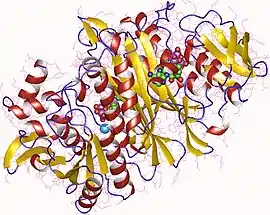Phosphoribosylformylglycinamidine synthase
In enzymology, a phosphoribosylformylglycinamidine synthase (EC 6.3.5.3) is an enzyme that catalyzes the chemical reaction
- ATP + N2-formyl-N1-(5-phospho-D-ribosyl)glycinamide + L-glutamine + H2O ADP + phosphate + 2-(formamido)-N1-(5-phospho-D-ribosyl)acetamidine + L-glutamate
| Phosphoribosylformylglycinamidine synthase | |||||||||
|---|---|---|---|---|---|---|---|---|---|
 FGAM syntethase II monomer, Thermotoga maritima | |||||||||
| Identifiers | |||||||||
| EC no. | 6.3.5.3 | ||||||||
| CAS no. | 9032-84-2 | ||||||||
| Databases | |||||||||
| IntEnz | IntEnz view | ||||||||
| BRENDA | BRENDA entry | ||||||||
| ExPASy | NiceZyme view | ||||||||
| KEGG | KEGG entry | ||||||||
| MetaCyc | metabolic pathway | ||||||||
| PRIAM | profile | ||||||||
| PDB structures | RCSB PDB PDBe PDBsum | ||||||||
| Gene Ontology | AmiGO / QuickGO | ||||||||
| |||||||||
The 4 substrates of this enzyme are ATP, N2-formyl-N1-(5-phospho-D-ribosyl)glycinamide, L-glutamine, and H2O, whereas its 4 products are ADP, phosphate, 2-(formamido)-N1-(5-phospho-D-ribosyl)acetamidine, and L-glutamate.
This enzyme belongs to the family of ligases, specifically those forming carbon-nitrogen bonds carbon-nitrogen ligases with glutamine as amido-N-donor. The systematic name of this enzyme class is N2-formyl-N1-(5-phospho-D-ribosyl)glycinamide:L-glutamine amido-ligase (ADP-forming). Other names in common use include phosphoribosylformylglycinamidine synthetase, formylglycinamide ribonucloetide amidotransferase, phosphoribosylformylglycineamidine synthetase, FGAM synthetase, FGAR amidotransferase, 5'-phosphoribosylformylglycinamide:L-glutamine amido-ligase, (ADP-forming), 2-N-formyl-1-N-(5-phospho-D-ribosyl)glycinamide:L-glutamine, and amido-ligase (ADP-forming).[1][2]
It is known as ADE6 in Saccharomyces cerevisiae (budding yeast) genetics.[3]
Structural studies
As of late 2007, 8 structures have been solved for this class of enzymes, with PDB accession codes 1T3T, 1VK3, 1VQ3, 2HRU, 2HRY, 2HS0, 2HS3, and 2HS4.
Regulation
This enzyme participates in purine metabolism. Oncogenic and physiological signals lead to the ERK-dependent PFAS phosphorylation at the T619 site, stimulating de novo purine synthesis flux. In addition, ERK-mediated PFAS phosphorylation is required for cell and tumor growth.[4]
References
- Ali, Eunus S.; Sahu, Umakant; Villa, Elodie; O’Hara, Brendan P.; Gao, Peng; Beaudet, Cynthia; Wood, Antony W.; Asara, John M.; Ben-Sahra, Issam (18 June 2020). "ERK2 Phosphorylates PFAS to Mediate Posttranslational Control of De Novo Purine Synthesis". Molecular Cell. 78 (6): 1178–1191.e6. doi:10.1016/j.molcel.2020.05.001. PMC 7306006. PMID 32485148.
- MELNICK I, BUCHANAN JM (1957). "Biosynthesis of the purines. XIV. Conversion of (alpha-N-formyl) glycinamide ribotide to (alpha-N-formyl) glycinamidine ribotide purification and requirements of the enzyme system". J. Biol. Chem. 225 (1): 157–62. doi:10.1016/S0021-9258(18)64918-X. PMID 13416226.
- Matsumoto, K.; Stotz, A.; Andreichuk YuV; Nielsen, I.S.; Paluh, J.L.; Hoffman, R.A. "ADE6 - phosphoribosylformylglycinamidine synthase". Wikigenes. PubMed. Retrieved 21 October 2019.
- Ali, ES; Sahu, U; Villa, E; O'Hara, BP; Gao, P; Beaudet, C; Wood, AW; Asara, JM; Ben-Sahra, I (18 June 2020). "ERK2 Phosphorylates PFAS to Mediate Posttranslational Control of De Novo Purine Synthesis". Molecular Cell. 78 (6): 1178–1191.e6. doi:10.1016/j.molcel.2020.05.001. PMC 7306006. PMID 32485148.